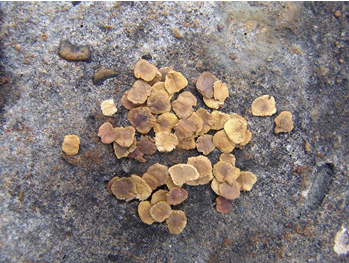Ecological sketch and potentials of abey (Jacaranda arborea Urb.) for ecological rehabilitation and restoration in the northeast Cuban
Main Article Content
Abstract
The abey (Jacaranda arborea) is a plant in the family Bignonaceae, is endemic to the Northeast, from Sierra de Nipe to Baracoa, basically in ecosystems on serpentines. The objectives of the work highlighted some ecological characteristics of the species, as well as its role forecologicalrehabilitation and restoration at sitesimpactedbyvariousanthropogenic and natural actions.Themethodology usedanalyzedthepresence/absence in differentplantformations, seedharvesting, experimental testing of their asexual reproduction (bystakes) at thesame time as testingthegerminationcapacity of botanicalseeds. The results showed that 89.3% of individuals has the ability to regrow through the stump, their seeds have an average germination power of 96.3%, and it was found to have a strong behavior to colonize impacted sites, for example, road edges, points where original vegetation was lost by mining, forestry and agriculture.
Article Details

This work is licensed under a Creative Commons Attribution-NonCommercial 4.0 International License.
References
Barnes, A.D., Jochun, M., Mumme, S., Haneda, N.F., Farajallah, A., Wirdato, T.H., Brose, U. (2014). Consequences of tropica land use for multitrophic biodiversity and ecosystem functioning. Nature Communications 5:5351.
Begué-Quiala, G., J. L. Delgado Labañino, T. Hernández Columbié y J. Gámez Diez. (2019). Restauración ecológica de sitios afectados por prospecciones mineras en la cuenca del Toa. Revista Ciencias de la Tierra y el Espacio, enero-junio, 2019, Vol.19, No.1, pp. 44-55.
Begué-Quiala, G., Delgado Labañino, J. L., González Álvarez, A. y Pérez Trejo, H. M. (2016). Biología y manejo adaptativo de Sideroxylonmoaense (Bisse& J. E Gut.) J. E Gut. (Sapotaceae), recurso fitogenético endémico del nororiente de Cuba. Revista Agrotecnia de Cuba ISSN digital 2414-4673, 2016, 40(2): pp. 9-15.
Berazaín, R. (1999). Estudio en plantas acumuladoras e hiper acumuladoras de níquel en las serpentinas del Caribe. Revista del Jardín Botánico Nacional, Vol. XX, pp.17-30.
Bollo Manent, M. (1982). Compendio de geografía de los suelos, La Habana, MES, Universidad de la Habana, Facultad de Geografía, 338 p.
Cameratti, G. (1969). Estudio de la brotación de tocones de Eucalyptus globulus Labill. Tesis de Ingeniero Forestal. Valdivia, Universidad Austral de Chile, Facultad de Ciencias Forestales, 33 p.
Capote, R. y R. Berazaín (1984): Clasificación de las formaciones vegetales de Cuba. Rev, Jard. Bot. Nac. Cuba, V (2): 1-48.
Hirukawa, M., M. Zhang, L. M Echenique-Díaz, K. Mizota, S. Ohdachi, G. Begué-Quiala, J.L. Delgado-Labañino, J. Gámez-Diez, J. Álvarez-Lemus, L. Galano-Machado, M. Súarez-Nuñez, T. Shibata, H. Kigoshi y M. Kita. (2020). Insolation and structure-activity relationship studies of jacaranones: anti-inflammatory quinoids the Cuba endemic plant Jacaranda arborea (Bignoneaceae). Journal Tetrahedron Letters 61 (2020) 152005 (1-8).
Primack, R. y Massardo, F. (2001). Restauración ecológica. En: Primack, R., Rozzi, R., Massardo, F., y Feinsiger, P. (eds.). Fundamentos de conservación biológica. Perspectivas latinoamericanas. Fondo de Cultura Económica, México, 797 p.
Serra, M. (1987). Dendrología de angiosperma dialipétalas y simpétalas. Segunda Parte. Universidad de Chile. Apuntes de clases. Facultad de Ciencias Agrarias y Forestales. Departamento de Silvicultura. Santiago. Chile, 47 p.
Vita, A. (1996). Los tratamientos silviculturales. Universidad de Chile. Facultad de Ciencias Agrarias y Forestales, 149 p.

